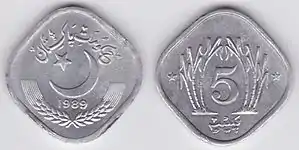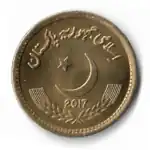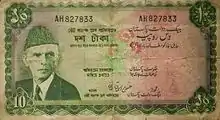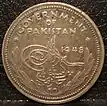 Rs. 20/-, Rs. 100/-, Rs. 500/- and Rs. 1,000/- banknotes | |
| ISO 4217 | |
|---|---|
| Code | PKR (numeric: 586) |
| Subunit | 0.01 |
| Unit | |
| Unit | Rupee |
| Symbol | Re. /- (singular) Rs. /- (plural) |
| Denominations | |
| Subunit | |
| 1⁄100 | Paisa (defunct); Paisa denominated coins ceased to be legal tender in 2013[1] |
| Banknotes | |
| Freq. used | Rs. 10/-, Rs. 20/-, Rs. 50/-, Rs. 100/-, Rs. 500/-, Rs. 1,000/-, Rs. 5,000/- |
| Rarely used | Rs. 75/- |
| Coins | |
| Freq. used | Re. 1/-, Rs. 2/-, Rs. 5/- |
| Rarely used | Rs. 10/- |
| Demographics | |
| Official user(s) | |
| Unofficial user(s) | |
| Issuance | |
| Central bank | State Bank of Pakistan |
| Website | www |
| Printer | Pakistan Security Printing Corporation |
| Mint | Pakistan Mint |
| Valuation | |
| Inflation | 35.37% (2023) |
The Pakistani rupee (ISO code: PKR) is the official currency in the Islamic Republic of Pakistan. The issuance of the currency is controlled by the State Bank of Pakistan. It was officially adopted by the Government of Pakistan in 1949. Earlier the coins and notes were issued and controlled by the Reserve Bank of India until 1949, when it was handed over to the Government and State Bank of Pakistan, by the Government and Reserve Bank of India.
In Pakistani English, large values of rupees are counted in thousands; lakh (hundred thousands); crore (ten-millions); Arab (billion); kharab (hundred billion). Numbers are still grouped in thousands (123,456,789 rather than 12,34,56,789 as written in India)
History



The word rūpiya is derived from the Sanskrit word rūpya, which means "wrought silver, a coin of silver",[3] in origin an adjective meaning "shapely", with a more specific meaning of "stamped, impressed", whence "coin". It is derived from the noun rūpa "shape, likeness, image". Rūpaya was used to denote the coin introduced by Sher Shah Suri during his reign from 1540 to 1545 CE.
The Pakistan (Monetary System and Reserve Bank) Order, 1947 was issued on August 14, 1947, by the Governor General of pre-partition British Indian, following the advice of an expert committee.[4] It designated the Reserve Bank of India (RBI) as the temporary monetary authority for both India and Pakistan until September 30, 1948.[4] During this transitional period, currency notes issued by the RBI and the Government of India were to remain legal tender in Pakistan.[4] The order also allowed these notes to bear inscriptions of Government of Pakistan in Urdu and English, to be circulated from April 1, 1948.[4] Like the Indian rupee, it was originally divided into 16 annas, each of 4 pice or 12 pie.
For the first seven months following partition, currency issued by the RBI and the Government of India continued to circulate in Pakistan.[4] Modified RBI notes in denominations of 2, 5, 10, and 100 rupees, and 1-rupee notes from the Government of India were later introduced.[4] The modifications involved inscribing Government of Pakistan in English and "Hakumat-e-Pakistan" in Urdu on the front of the notes.[4]
An early 1948 agreement between the governments of India and Pakistan resulted in an amendment to the Pakistan (Monetary System and Reserve Bank) Order, 1947, moving up the deadline for the RBI's role as Pakistan's monetary authority from September 30, 1948, to June 30, 1948.[4] Concurrently, the arrangement for the RBI to supply inscribed Indian notes to Pakistan was terminated on June 30, 1948.[4]
In January 1961, the currency was decimalised, with the rupee subdivided into 100 pice, renamed (in English) paise (singular paisa) later the same year. However, coins denominated in paise have not been issued since 1994.
Coins








In 1948, coins were introduced in denominations of 1 pice, 1⁄2, 1 and 2 annas, 1⁄4, 1⁄2 and 1 rupee. 1 pie coins were added in 1951. In 1961, coins for 1, 5 and 10 pice were issued, followed later the same year by 1 paisa, 5 and 10 paise coins. In 1963, 10 and 25 paise coins were introduced, followed by 2 paise the next year. Re. 1/- coins were reintroduced in 1979, followed by Rs. 2/- in 1998 and Rs. 5/- in 2002. 2 paise coins were last minted in 1976, with 1 paisa coins ceasing production in 1979. The 5, 10, 25 and 50 paise all ceased production in 1996. There are two variations of Rs. 2/- coins: most have clouds above the Badshahi Masjid but many do not. The Re. 1/- and Rs. 2/- coins were changed to aluminium in 2007.
Paisa denominated coins ceased to be legal tender in 2013, leaving the Re. 1/- coin as the minimum legal tender.[1] On 15 October 2015, the Pakistan government introduced a revised Rs. 5/- coin with a reduced size and weight and having a golden colour, made from a composition of copper-nickel-zinc, and also in 2016 a Rs. 10/- coin was introduced into circulation.
In 2019 the Pakistan government introduced a commemorative Rs. 50/- coin to celebrate the 550th birthday of Guru Nanak and in tribute of opening of new Gurdwara of Kartarpur, Pakistan.[5]
| Currently circulating coins | ||||||
|---|---|---|---|---|---|---|
| Obverse | Reverse | Value | Years in use | Composition | Obverse illustration | Reverse illustration |
| Re. 1/- | 1998 – present | Bronze (1998-2006) Aluminium (2007–present) |
Quaid-e-Azam, Muhammad Ali Jinnah |
Hazrat Lal Shahbaz Qalandar Mausoleum, Sehwan Shareef | ||
 |
 |
Rs. 2/- | 1998 – present | Brass (1998-1999) Nickel-brass (1999-2006) Aluminium (2007-) |
Crescent and Star | Badshahi Masjid, Lahore |
 |
 |
Rs. 5/- | 2002 – present | Cupronickel (2002-2011) Copper-Zinc-Nickel (2015–present) |
Crescent and Star | Number "5" |
 |
_-_2022-09-07_at_13.45.33.jpg.webp) |
Rs. 10/- | 2016 – present | Nickel-brass | Crescent and Star | Faisal Mosque, Islamabad |
| For table standards, see the coin specification table. | ||||||
Banknotes
On 1 April 1948, provisional notes were issued by the Reserve Bank of India and the Government of India on behalf of the Government of Pakistan, for use exclusively within Pakistan, without the possibility of redemption in India. Printed by the India Security Press in Nasik, these notes consist of Indian note plates engraved (not overprinted) with the words GOVERNMENT OF PAKISTAN in English and "Hukumat-e-PAKISTAN" in Urdu added at the top and bottom, respectively, of the watermark area on the front only; the signatures on these notes remain those of Indian banking and finance officials.[6] Additionally, the United Kingdom's Thomas De La Rue and Company, along with Bradbury Wilkinson and Company, manufactured various denominations for Pakistan.[4]

After the independence, the Pakistani government established a national security printing facility in 1949, named the Pakistan Security Printing Corporation (PSPC).[4] This venture, a partnership between Thomas De La Rue & Co. Ltd. (holding a 40% stake) and the Pakistani Government (with a 60% stake), started with a capital of 7.5 million rupees. The foundation for the facility was laid in Karachi by the Governor General of Pakistan on March 11, 1949.[4] In selecting a printing method, the PSPC chose the intaglio process over the lithographic method due to concerns about counterfeiting and regional security issues with India. This decision reflected a preference for a higher-security printing technique.[4]
Regular government issues commenced in 1948 in denominations of Re. 1/-, Rs. 5/-, Rs. 10/- and Rs. 100/-. The government continued to issue Re. 1 notes until the 1980s but another note-issuing was taken over by the State Bank of Pakistan in 1953 when Rs. 2/-, Rs. 5/-, Rs. 10/- and Rs. 100/- notes were issued. Only a few Rs. 2/- notes were issued. Rs. 50/- notes were added in 1957, with Rs. 2/- notes reintroduced in 1985. In 1986, Rs. 500/- notes were introduced, followed by Rs. 1,000/- the next year. Rs. 2/- and Rs. 5/- notes were replaced by coins in 1998 and 2002. Rs. 20/- notes were added in 2005, followed by Rs. 5,000/- in 2006. Until 1971, Pakistan banknotes were bilingual, featuring Bengali translation of the Urdu text (where the currency was renamed taka), since Bengali was the state language of East Pakistan (now Bangladesh).[7]
The PSPC began issuing its own 1- and 5-rupee notes in the fiscal year 1952-53.[4] These notes resembled those previously produced by Thomas de la Rue & Company, but the 1-rupee note featured a notable change: a blue back without under-print, different from the purple back of the British versions. This new design was circulated on January 31, 1953.[4]
On December 14, 1963, the State Bank of Pakistan started operating its own printing press, eventually taking over all national banknote production.[4] Later, the 1-rupee note was modified to include a purple back with pink and blue under-print, similar to the De La Rue design.[4] Variations of the 1-rupee note are identified by differences in the serial number font and signature styles.[4]
Although the PSPC had been printing lower denomination notes since July 1953, the third series of the 100-rupee note, released in September 1953, was initially produced by Thomas De La Rue in the UK.[4] Subsequently, these notes were printed by the PSPC, with the change in production source identifiable by variations in the serial number font.[4]
Banknote features
All banknotes other than the Re. 1/- and Rs. 2/- feature a portrait of Muhammad Ali Jinnah on the obverse along with writing in Urdu. The reverses of the banknotes vary in design and have English text. The only Urdu text found on the reverse is the Urdu translation of the Prophetic Hadith, "Seeking an honest livelihood is an act of worship." which is حصول رزق حلال عبادت ہے (Hasool-e-Rizq-e-Halal Ibaadat hai).
The banknotes vary in size and colour, with larger denominations being longer than smaller ones. All contain multiple colours. However, each denomination does have one colour which predominates. All banknotes feature a watermark for security purposes. On the larger denomination notes, the watermark is a picture of Jinnah, while on smaller notes, it is a crescent and star. Different types of security threads are also present in each banknote.
List of banknotes
| Banknotes before the 2005 series[8] | ||||||
|---|---|---|---|---|---|---|
| Image | Value | Dimensions | Main color | Description – Reverse | Status | |
| Obverse | Reverse | |||||
| Re. 1/- | 95 × 66 mm | Brown | Tomb of Muhammad Iqbal in Lahore | No longer in circulation | ||
| Rs. 2/- | 109 × 66 mm | Purple | Badshahi Masjid in Lahore | |||
| Rs. 5/- | 127 × 73 mm | Burgundy | Khojak Tunnel in Balochistan | |||
| Rs. 10/- | 141 × 73 mm | Green | Mohenjo-daro in Larkana District | No longer in circulation | ||
| Rs. 50/- | 154 × 73 mm | Purple and red | Alamgiri Gate of the Lahore Fort in Lahore | |||
| Rs. 100/- | 165 × 73 mm | Red and orange | Islamia College in Peshawar | |||
| Rs. 500/- | 175 × 73 mm | Green, tan, red, and orange | The State Bank of Pakistan in Islamabad | No longer in circulation | ||
| Rs. 1,000/- | 175 × 73 mm | Blue | Tomb of Jahangir in Lahore | |||
The State Bank has started a new series of banknotes, phasing out the older designs for new, more secure ones.
| Value | Dimensions | Main colour | Description | Date of | Ref. | |||||
|---|---|---|---|---|---|---|---|---|---|---|
| Obverse | Reverse | Watermark | issue | withdrawal | lapse | |||||
| Rs. 5/- | 115 × 65 mm | Olive and grey | Muhammad Ali Jinnah | Gwadar Port | Muhammad Ali Jinnah and "5" | 8 July 2008 | 31 December 2011 | 31 December 2012 | [9][10] | |
| Rs. 10/- | 115 × 65 mm | Olive | Bab-e-Khyber (entrance to the Khyber Pass) | Muhammad Ali Jinnah and "10" | 27 May 2006 | Current | [11] | |||
| Rs. 20/- | 123 × 65 mm | Burgundy | Mohenjo-daro | Muhammad Ali Jinnah and "20" | 13 August 2005 | Current | [12] | |||
| Orange | 22 March 2008 | Current | [13] | |||||||
| Rs. 50/- | 131 × 65 mm | Purple | K2 | Muhammad Ali Jinnah and "50" | 8 July 2008 | Current | [14] | |||
| Rs. 100/- | 139 × 65 mm | Red | Quaid-e-Azam Residency | Muhammad Ali Jinnah and "100" | 11 November 2006 | Current | [15] | |||
| Rs. 500/- | 147 × 65 mm | Green | Badshahi Mosque | Muhammad Ali Jinnah and "500" | 11 November 2006 | Current | [16] | |||
| Rs. 1,000/- | 155 × 65 mm | Blue | Islamia College in Peshawar | Muhammad Ali Jinnah and "1000" | 26 February 2007 | Current | [17] | |||
| Rs. 5,000/- | 163 × 65 mm | Brown | Faisal Mosque | Muhammad Ali Jinnah and "5000" | 27 May 2006 | Current | [18] | |||
| For table standards, see the banknote specification table. | ||||||||||
Hajj and special anniversary banknotes
Pakistan put foreign exchange controls in place in 1949, restricting the export and import of currency except for when needed for Hajj in Saudi Arabia. This created an opportunity for smuggling, leading Pakistan to issue special Hajj notes for use by pilgrims. These were differentiated by an overprint in English "For pilgrims from Pakistan for use in Saudi Arabia and Iraq".[19]
Although other means of exchange were considered, the high level of illiteracy amongst the Pakistani pilgrims and the additional costs that would be incurred through the need to purchase such means prevented the government from these methods of exchange. The State Bank Order to allow the issue of these Hajj notes was made in May 1950.
A new series of notes was released in 1972, under the name of the State Bank of Pakistan rather than the Government of Pakistan. These had an Urdu overprint as well as an English one, saying "For Haj [sic] pilgrims from Pakistan for use in Saudi Arabia only". New notes were printed in 1975 and 1978, reflecting changes in the standard notes.[19] The use of Hajj notes continued until 1978.
Until this date, stocks of notes were used without the necessity of printing new notes with the signatures of the later Governors. It is believed that, once the use of Hajj Notes was discontinued, most of the remaining stock of notes were destroyed. However, many notes entered the collector market following their sale to a banknote dealer by the State Bank of Pakistan.
Commemorative banknotes were also issued for the 50th and 75th anniversaries of national independence, including the unusual denomination of 75 rupees in the latter instance.
| Hajj banknotes | |||||
|---|---|---|---|---|---|
| Image | Value | Main colour | Description – Reverse | Date of usage | |
| Obverse | Reverse | ||||
| Rs. 10/- | Dark purple | Shalimar Gardens in Lahore | 1960–1969 | ||
| Rs. 10/- | Dark blue | Mohenjo-daro in Larkana | 1970–1976 | ||
| Rs. 100/- | Dark orange | Islamia College (Peshawar) | 1970–1976 | ||
| For table standards, see the banknote specification table. | |||||
| Special banknotes for the 50th and 75th anniversary of the Independence of Pakistan | ||||||
|---|---|---|---|---|---|---|
| Image | Value | Main colour | Description – Front | Description – Reverse | Date of usage | |
| Obverse | Reverse | |||||
| Rs. 5/- | Dark purple | Quaid-e-Azam Muhammad Ali Jinnah | Baha-ud-din Zakariya Tomb Multan | 1997 | ||
| For table standards, see the banknote specification table. | ||||||
| Value | Dimensions | Main colour | Description | Date of issue | Ref. | |||
|---|---|---|---|---|---|---|---|---|
| Obverse | Reverse | Watermark | ||||||
| Rs. 75/- | 147 × 65 mm | Green | Muhammad Ali Jinnah, Muhammad Iqbal, Fatima Jinnah, Syed Ahmad Khan | Markhor, Deodar tree | Muhammad Ali Jinnah and "75" | 30 September 2022 | [20] | |
| Rs. 75/- | 139 × 65 mm | Blue | Muhammad Ali Jinnah, Building of the State Bank of Pakistan | Fatima Jinnah | Muhammad Ali Jinnah and "75" | July 2023 | [21] | |
| For table standards, see the banknote specification table. | ||||||||
Exchange rate

Since the United States dollar suspension in 1971 of convertibility of paper currency into any precious metal, the Pakistani rupee has been fiat money. Before the collapse of Bretton Woods system, currency was pegged at fixed exchange rate to the United States dollar for international trade, with the dollar convertible to gold for foreign governments only.
The rupee was pegged to sterling until 1982 when the government of General Zia-ul-Haq changed to a managed float. As a result, the rupee devalued by 38.5% between 1982–83 and 1987–88 and the cost of importing raw materials increased rapidly, causing pressure on Pakistani finances and damaging much of the industrial base. The Pakistani rupee depreciated against the United States dollar until the turn of the century, when Pakistan's large current account surplus pushed the value of the rupee up against the dollar. The State Bank of Pakistan then stabilized the exchange rate by lowering interest rates and buying dollars, in order to preserve the country's export competitiveness.
2008 was termed a disastrous year for the rupee after the elections: between December 2007 and August 2008 it lost 23% of its value, falling to a record low of Rs.79/20 against the US dollar.[22] The major reasons for this depreciation were huge current and trade accounts deficits that had built up since the credit boom in Pakistan after 2002. Due to rising militancy in the Khyber Pakhtunkhwa province and its tribal areas, foreign direct investment began to fall, and the structural problems of the balance of payment were exposed; foreign exchange reserves fell disastrously to as low as US$2 billion.
The rupee continued to slowly decline until the start of 2018, when it began to rapidly devalue. The crash worsened midway through 2021, with the Pakistani rupee losing almost half its value between May 2021 and May 2023. This is largely attributed to political instability, devastating flooding, and a debt crisis.
The Pakistani rupee gained it value at the end of September until mid October 2023 with Pakistan's Federal Investigation Agency embarking on a country-wide raid on exchange companies involved in illegal dollar transactions, which involved the buying and selling of dollars through informal channels without documentation.[23] Since then Pakistani became the best performing currency of September 2023 against US dollar.
The Pakistani rupee last traded at 286.96 against the US dollar as of November 12, 2023.[24]
| Current PKR exchange rates | |
|---|---|
| From Google Finance: | AUD CAD CHF CNY EUR GBP HKD JPY USD RUB |
| From Yahoo! Finance: | AUD CAD CHF CNY EUR GBP HKD JPY USD RUB |
| From XE.com: | AUD CAD CHF CNY EUR GBP HKD JPY USD RUB |
| From OANDA: | AUD CAD CHF CNY EUR GBP HKD JPY USD RUB |
See also
Notes
- 1 2 "The News International: Latest News Breaking, Pakistan News". www.thenews.com.pk. Archived from the original on 24 December 2013. Retrieved 28 April 2018.
- ↑ Rahimi, Haroun (21 October 2022). Reform and Regulation of Economic Institutions in Afghanistan: Formal and Informal Credit Systems. Taylor & Francis. p. 91. ISBN 978-1-000-76863-3.
- ↑ "Etymology of rupee". 20 September 2008. Archived from the original on 10 November 2013. Retrieved 25 July 2013.
- 1 2 3 4 5 6 7 8 9 10 11 12 13 14 15 16 17 18 19 20 "The Banknotes of Pakistan 1947-1972". www.pjsymes.com.au.
- ↑ "Pakistan issues coin to mark Guru Nanak's 550th birth anniversary". hindustantimes. 15 June 2019. Retrieved 23 June 2020.
- ↑ Linzmayer, Owen (2012). "Pakistan". The Banknote Book. San Francisco, CA: www.BanknoteNews.com. Archived from the original on 29 August 2012.
- ↑ Roshaan, Hamid. "A collection of Pakistani Currency Notes". Archived from the original on 13 June 2014. Retrieved 26 May 2014.
- ↑ "Banknotes and Coins Under Circulation" (PDF). State Bank of Pakistan. Archived (PDF) from the original on 9 September 2008. Retrieved 17 September 2008.
- ↑ "Banknotes - Rupees 5". State Bank of Pakistan. Karachi. Archived from the original on 20 August 2008. Retrieved 3 July 2023.
- ↑ Maqbool, Imran (8 July 2011). "Demonetization of Rs 500 Old-Design and Rs 5 Banknotes" (PDF). State Bank of Pakistan. Karachi. Archived from the original (PDF) on 25 July 2011. Retrieved 3 July 2023.
- ↑ "Banknotes - Rupees 10". State Bank of Pakistan. Karachi. Archived from the original on 8 August 2008. Retrieved 3 July 2023.
- ↑ "Pakistan Bank Note (Rupees 20)". State Bank of Pakistan. Karachi. Archived from the original on 5 September 2008. Retrieved 3 July 2023.
- ↑ "Banknotes - Rupees 20". State Bank of Pakistan. Karachi. Archived from the original on 4 September 2008. Retrieved 3 July 2023.
- ↑ "Banknotes - Rupees 50". State Bank of Pakistan. Karachi. Archived from the original on 4 September 2008. Retrieved 3 July 2023.
- ↑ "Banknotes - Rupees 100". State Bank of Pakistan. Karachi. Archived from the original on 17 September 2008. Retrieved 3 July 2023.
- ↑ "Banknotes - Rupees 500". State Bank of Pakistan. Karachi. Archived from the original on 17 September 2008. Retrieved 3 July 2023.
- ↑ "Banknotes - Rupees 1000". State Bank of Pakistan. Karachi. Archived from the original on 19 September 2008. Retrieved 3 July 2023.
- ↑ "Banknotes - Rupees 5000". State Bank of Pakistan. Karachi. Archived from the original on 15 September 2008. Retrieved 3 July 2023.
- 1 2 "Haj Notes". State Bank of Pakistan Museum. Retrieved 20 February 2023.
- ↑ "Commemorative Banknotes". State Bank of Pakistan. Karachi. Archived from the original on 3 July 2023. Retrieved 3 July 2023.
- ↑ "Commemorative Banknotes". State Bank of Pakistan. Karachi. Archived from the original on 5 July 2023. Retrieved 5 July 2023.
- ↑ "Pakistan rupee falls to new low". BBC News. 15 August 2008. Archived from the original on 30 August 2008. Retrieved 17 September 2008.
- ↑ Shan, Lee Ying (18 October 2023). "This currency is now the world's top performer, after rebounding from record lows". CNBC. Retrieved 24 November 2023.
- ↑ "USD to PKR Exchange Rate". Bloomberg.com.
External links
- SBP's webpage on the newnotes
- Business Recorder: Pakistan's first financial newspaper
- State Bank to issue Rs.5000/- and New Rs.10/- Banknotes from 27 May 2006: Governor

